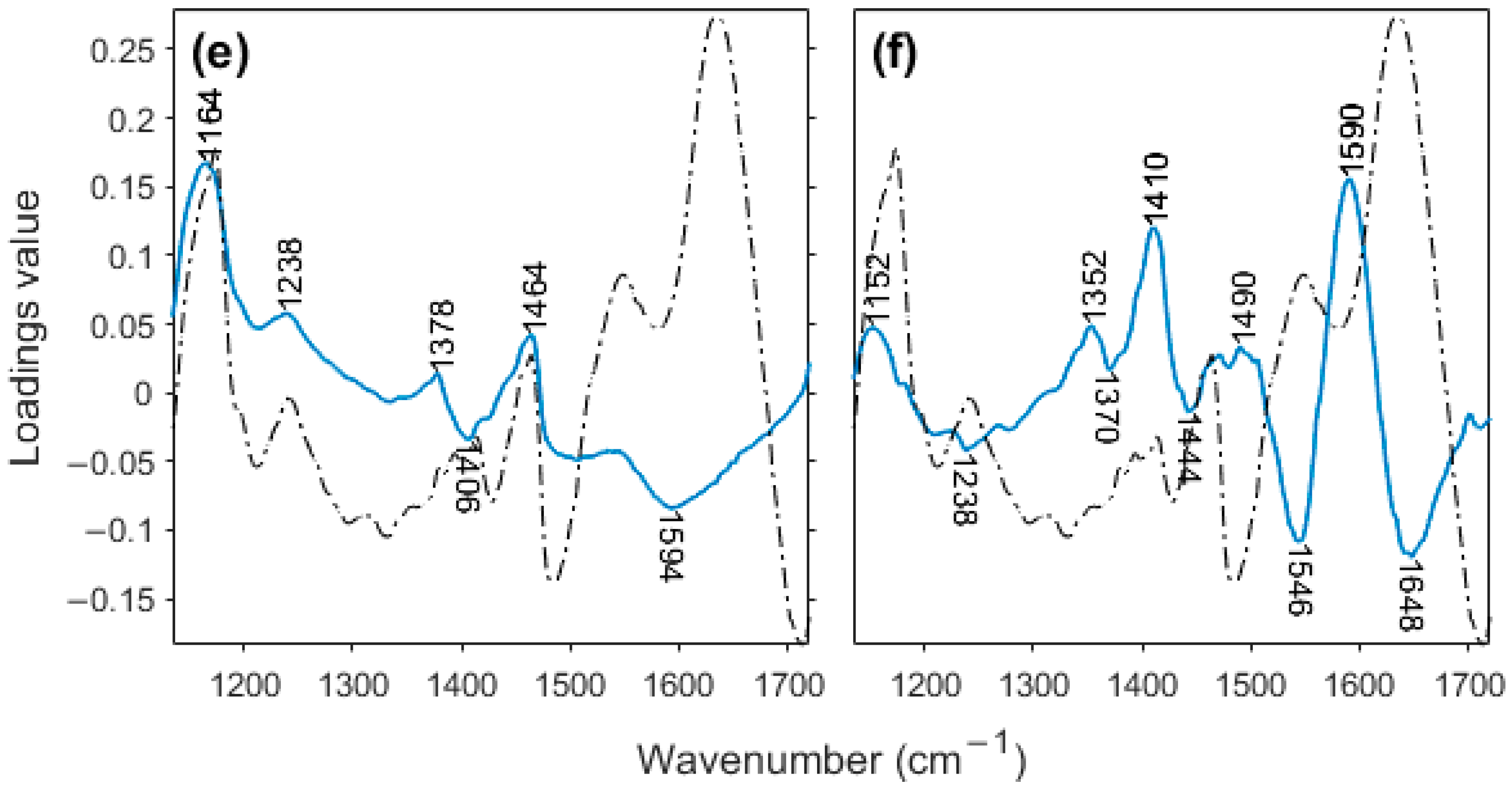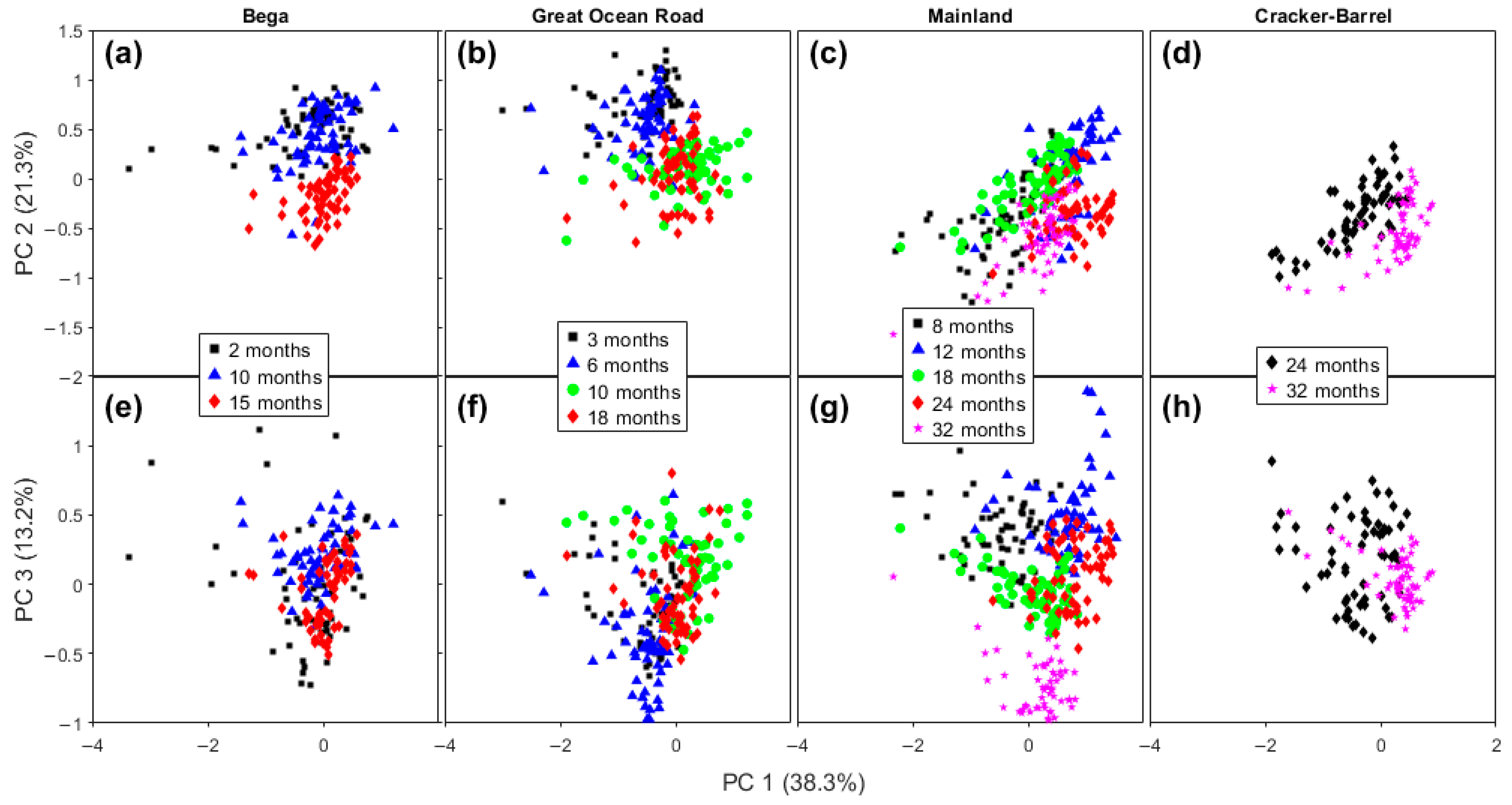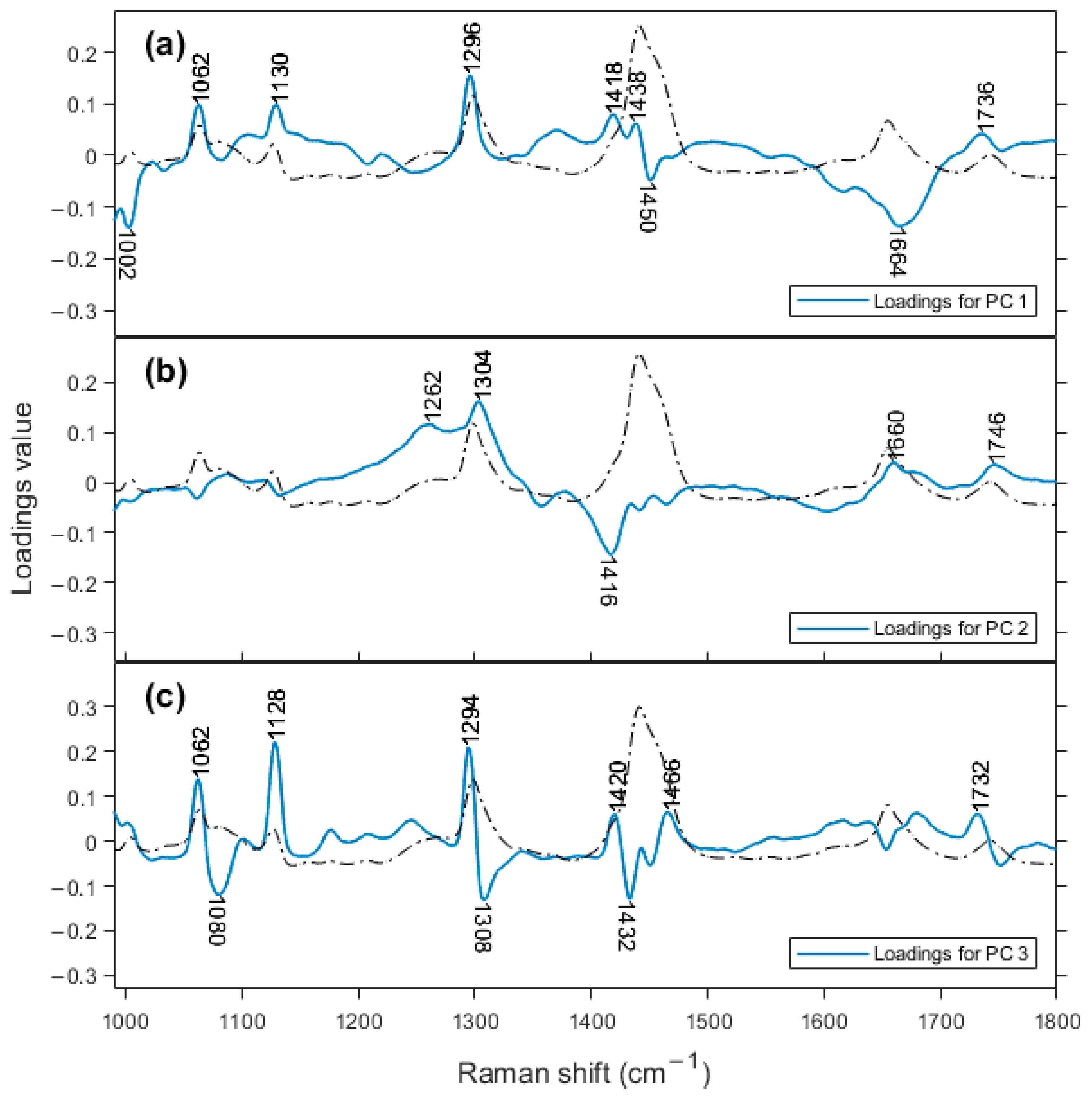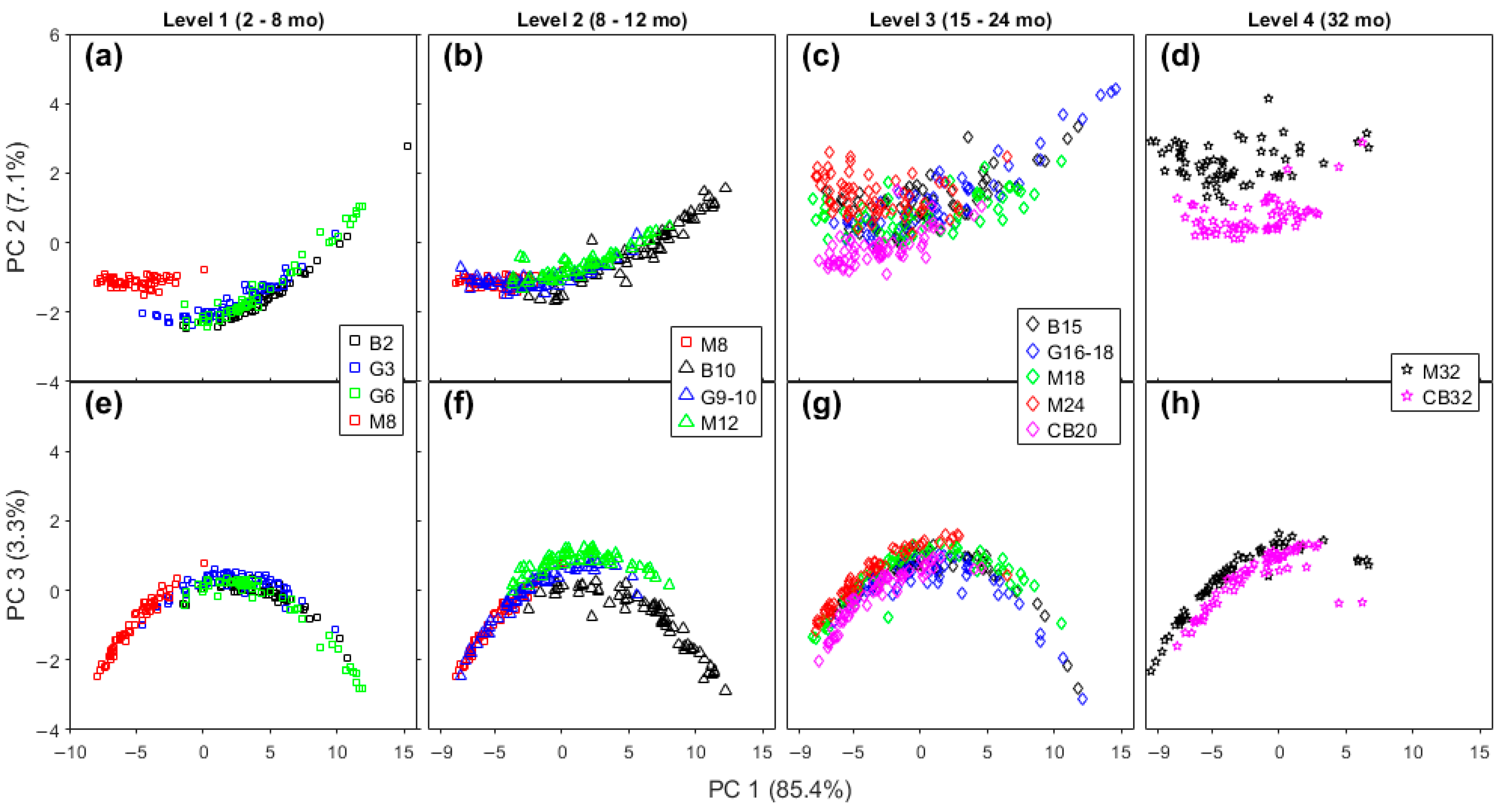Identifying Chemical Differences in Cheddar Cheese Based on Maturity Level and Manufacturer Using Vibrational Spectroscopy and Chemometrics
Abstract
:1. Introduction
2. Results and Discussion
2.1. Spectral Characterization of Commercial Cheddar Cheese
2.2. Aging Effects within the Same Brand
2.2.1. FTIR Spectral Range
2.2.2. FTIR PCA
2.2.3. FTIR Spectrum Interpretation
2.2.4. Raman Spectral Range
2.2.5. Raman PCA
2.2.6. Raman Spectra Interpretation
2.3. Comparing Manufacturer Using Samples with Similar Ripening Time
2.4. Features Detected by FTIR and Raman Spectroscopies
3. Materials and Methods
3.1. Samples
3.2. Spectral Sampling Acquisition
3.2.1. FTIR
3.2.2. Raman
3.3. Multivariate Analysis
4. Conclusions
Supplementary Materials
Author Contributions
Funding
Institutional Review Board Statement
Informed Consent Statement
Data Availability Statement
Conflicts of Interest
References
- Fox, P.F.; Guinee, T.P.; Cogan, T.M.; McSweeney, P.L.H. (Eds.) Principal Families of Cheese. In Fundamentals of Cheese Science; Springer: Boston, MA, USA, 2017; pp. 27–69. [Google Scholar]
- Muir, D.; Hunter, E.; Banks, J.; Horne, D. Sensory properties of Cheddar cheese: Changes during maturation. Food Res. Int. 1995, 28, 561–568. [Google Scholar] [CrossRef]
- Fox, P.F.; Guinee, T.P.; Cogan, T.M.; McSweeney, P.L. Fundamentals of Cheese Science; Springer: Boston, MA, USA, 2017. [Google Scholar]
- Martín-del-Campo, S.; Picque, D.; Cosío-Ramírez, R.; Corrieu, G. Evaluation of chemical parameters in soft mold-ripened cheese during ripening by mid-infrared spectroscopy. J. Dairy Sci. 2007, 90, 3018–3027. [Google Scholar] [CrossRef]
- Ruiz, E.P.Z.; O’Donnell, C.P.; Izquierdo, M. Application of Chemometrics in the Determination of Spirits Authenticity. Rev. Cuba. De Ing. 2013, 4, 33–40. [Google Scholar]
- Martelo-Vidal, M.J.; Vazquez, M. Classification of red wines from controlled designation of origin by ultraviolet-visible and near-infrared spectral analysis. Cienc. E Tec. Vitivinic. 2014, 29, 35–43. [Google Scholar] [CrossRef]
- Kuswandi, B.; Cendekiawan, K.A.; Kristiningrum, N.; Ahmad, M. Pork adulteration in commercial meatballs determined by chemometric analysis of NIR Spectra. J. Food Meas. Charact. 2015, 9, 313–323. [Google Scholar] [CrossRef]
- Rohman, A. The employment of Fourier transform infrared spectroscopy coupled with chemometrics techniques for traceability and authentication of meat and meat products. J. Adv. Vet. Anim. Res. 2019, 6, 9–17. [Google Scholar] [CrossRef]
- Landry, J.D.; Torley, P.J.; Blanch, E.W. Detection of Biomarkers Relating to Quality and Differentiation of Some Commercially Significant Whole Fish Using Spatially Off-Set Raman Spectroscopy. Molecules 2020, 25, 3776. [Google Scholar] [CrossRef]
- Silva, L.K.R.; Santos, L.S.; Ferrao, S.P.B. Application of infrared spectroscopic techniques to cheese authentication: A review. Int. J. Dairy Technol. 2022, 75, 490–512. [Google Scholar] [CrossRef]
- Lei, T.; Sun, D.-W. Developments of nondestructive techniques for evaluating quality attributes of cheeses: A review. Trends Food Sci. Technol. 2019, 88, 527–542. [Google Scholar] [CrossRef]
- Subramanian, A.; Alvarez, V.B.; Harper, W.J.; Rodriguez-Saona, L.E. Monitoring amino acids, organic acids, and ripening changes in Cheddar cheese using Fourier-transform infrared spectroscopy. Int. Dairy J. 2011, 21, 434–440. [Google Scholar] [CrossRef]
- Margolies, B.J.; Barbano, D.M. Determination of fat, protein, moisture, and salt content of Cheddar cheese using mid-infrared transmittance spectroscopy. J. Dairy Sci. 2018, 101, 924–933. [Google Scholar] [CrossRef]
- Zhao, M.; Fearon, A.M.; O’Donnell, C.P.; Downey, G.; Beattie, R.J. Prediction of naturally-occurring, industrially-induced and total trans fatty acids in butter, dairy spreads and Cheddar cheese using vibrational spectroscopy and multivariate data analysis. Int. Dairy J. 2015, 51, 41–51. [Google Scholar] [CrossRef]
- Karoui, R.; Mouazen, A.M.; Dufour, E.; Pillonel, L.; Schaller, E.; Picque, D.; De Baerdemaeker, J.; Bosset, J.-O. A comparison and joint use of NIR and MIR spectroscopic methods for the determination of some parameters in European Emmental cheese. Eur. Food Res. Technol. 2006, 223, 44–50. [Google Scholar] [CrossRef]
- Skeie, S.; Feten, G.; Almoy, T.; Ostlie, H.; Isaksson, T. The use of near infrared spectroscopy to predict selected free amino acids during cheese ripening. Int. Dairy J. 2006, 16, 236–242. [Google Scholar] [CrossRef]
- Cevoli, C.; Fabbri, A.; Gori, A.; Maria Fiorenza, C.; Guarnieri, A. Screening of grated cheese authenticity by nir spectroscopy. J. Agric. Eng. 2013, 44, 264–268. [Google Scholar] [CrossRef]
- Karoui, R.; Mazerolles, G.; Bosset, J.O.; Baerdemaeker, J.d.; Dufour, E. Utilisation of mid-infrared spectroscopy for determination of the geographic origin of Gruyère PDO and L’Etivaz PDO Swiss cheeses. Food Chem. 2007, 105, 847–854. [Google Scholar] [CrossRef]
- Coppa, M.; Martin, B.; Hulin, S.; Guillemin, J.; Gauzentes, J.V.; Pecou, A.; Andueza, D. Prediction of indicators of cow diet composition and authentication of feeding specifications of Protected Designation of Origin cheese using mid-infrared spectroscopy on milk. J. Dairy Sci. 2021, 104, 112–125. [Google Scholar] [CrossRef] [PubMed]
- Li Vigni, M.; Durante, C.; Michelini, S.; Nocetti, M.; Cocchi, M. Preliminary Assessment of Parmigiano Reggiano Authenticity by Handheld Raman Spectroscopy. Foods 2020, 9, 1563. [Google Scholar] [CrossRef] [PubMed]
- Lei, T.; Lin, X.-H.; Sun, D.-W. Rapid classification of commercial Cheddar cheeses from different brands using PLSDA, LDA and SPA–LDA models built by hyperspectral data. J. Food Meas. Charact. 2019, 13, 3119–3129. [Google Scholar] [CrossRef]
- Yaman, H.; Aykas, D.P.; Jiménez-Flores, R.; Rodriguez-Saona, L.E. Monitoring the ripening attributes of Turkish white cheese using miniaturized vibrational spectrometers. J. Dairy Sci. 2022, 105, 40–55. [Google Scholar] [CrossRef]
- Chen, M.; Irudayaraj, J. Sampling technique for cheese analysis by FTIR spectroscopy. J. Food Sci. 1998, 63, 96–99. [Google Scholar] [CrossRef]
- Dufour, E.; Mazerolles, G.; Devaux, M.; Duboz, G.; Duployer, M.; Riou, N.M. Phase transition of triglycerides during semi-hard cheese ripening. Int. Dairy J. 2000, 10, 81–93. [Google Scholar] [CrossRef]
- Rodriguez-Saona, L.; Koca, N.; Harper, W.; Alvarez, V. Rapid determination of Swiss cheese composition by Fourier transform infrared/attenuated total reflectance spectroscopy. J. Dairy Sci. 2006, 89, 1407–1412. [Google Scholar] [CrossRef] [PubMed]
- Burdikova, Z.; Svindrych, Z.; Hickey, C.; Wilkinson, M.G.; Auty, M.A.E.; Samek, O.; Bernatova, S.; Krzyzanek, V.; Periasamy, A.; Sheehan, J.J. Application of advanced light microscopic techniques to gain deeper insights into cheese matrix physico-chemistry. Dairy Sci. Technol. 2015, 95, 687–700. [Google Scholar] [CrossRef]
- de Sá Oliveira, K.; de Souza Callegaro, L.; Cappa de Oliveira, L.F.; Almeida, M.R.; Stephani, R. Analysis of spreadable cheese by Raman spectroscopy and chemometric tools. Food Chem. 2016, 194, 441–446. [Google Scholar] [CrossRef]
- Gallier, S.; Gordon, K.C.; Jiménez-Flores, R.; Everett, D.W. Composition of bovine milk fat globules by confocal Raman microscopy. Int. Dairy J. 2011, 21, 402–412. [Google Scholar] [CrossRef]
- Li-Chan, E.C. Vibrational spectroscopy applied to the study of milk proteins. Le Lait 2007, 87, 443–458. [Google Scholar] [CrossRef]
- Ostovar Pour, S.; Afshari, R.; Landry, J.; Pillidge, C.; Gill, H.; Blanch, E. Spatially offset Raman spectroscopy: A convenient and rapid tool to distinguish cheese made with milks from different animal species. J. Raman Spectrosc. 2021, 52, 1705–1711. [Google Scholar] [CrossRef]
- Smith, G.P.S.; Holroyd, S.E.; Reid, D.C.W.; Gordon, K.C. Raman imaging processed cheese and its components. J. Raman Spectrosc. 2017, 48, 374–383. [Google Scholar] [CrossRef]
- Forrest, G. Raman spectroscopy of the milk globule membrane and triglycerides. Chem. Phys. Lipids 1978, 21, 237–252. [Google Scholar] [CrossRef]
- Lerma-García, M.; Gori, A.; Cerretani, L.; Simó-Alfonso, E.; Caboni, M. Classification of Pecorino cheeses produced in Italy according to their ripening time and manufacturing technique using Fourier transform infrared spectroscopy. J. Dairy Sci. 2010, 93, 4490–4496. [Google Scholar] [CrossRef] [PubMed]
- Boubellouta, T.; Karoui, R.; Lebecque, A.; Dufour, E. Utilisation of attenuated total reflectance MIR and front-face fluorescence spectroscopies for the identification of Saint-Nectaire cheeses varying by manufacturing conditions. Eur. Food Res. Technol. 2010, 231, 873–882. [Google Scholar] [CrossRef]
- de Jesus, J.C.; Silva, G.J.; Goncalves, B.; de Souza, M.R.; Santos, L.S.; Ferrao, S.P.B. Quick Identification of the Time of Maturation of Artisanal Minas Cheese by FTIR-ATR Spectroscopy and Multivariate Techniques. J. Braz. Chem. Soc. 2020, 31, 2000–2011. [Google Scholar] [CrossRef]
- Fagan, C.C.; O’donnell, C.; O’callaghan, D.; Downey, G.; Sheehan, E.; Delahunty, C.; Everard, C.; Guinee, T.; Howard, V. Application of mid-infrared spectroscopy to the prediction of maturity and sensory texture attributes of cheddar cheese. J. Food Sci. 2007, 72, E130–E137. [Google Scholar] [CrossRef] [PubMed]
- Motoyama, M.; Ando, M.; Sasaki, K.; Hamaguchi, H.-O. Differentiation of Animal Fats from Different Origins: Use of Polymorphic Features Detected by Raman Spectroscopy. Appl. Spectrosc. 2010, 64, 1244–1250. [Google Scholar] [CrossRef] [PubMed]
- Ramel, P.R.; Marangoni, A.G. Characterization of the polymorphism of milk fat within processed cheese products. Food Struct. 2017, 12, 15–25. [Google Scholar] [CrossRef]
- Holroyd, S.E.; Nickless, E.; Watkinson, P. Raman and mid-infrared spectroscopy to assess changes in Cheddar cheese with maturation. Int. J. Dairy Technol. 2023, 76, 408–417. [Google Scholar] [CrossRef]
- Downey, G.; Sheehan, E.; Delahunty, C.; O’Callaghan, D.; Guinee, T.; Howard, V. Prediction of maturity and sensory attributes of Cheddar cheese using near-infrared spectroscopy. Int. Dairy J. 2005, 15, 701–709. [Google Scholar] [CrossRef]
- McSweeney, P.L.; Olson, N.F.; Fox, P.F.; Healy, A.; Højrup, P. Proteolytic specificity of chymosin on bovine αs1,-casein. J. Dairy Res. 1993, 60, 401–412. [Google Scholar] [CrossRef] [PubMed]
- Sheehan, A.; Cuinn, G.O.; FitzGerald, R.; Wilkinson, M. Proteolytic enzyme activities in Cheddar cheese juice made using lactococcal starters of differing autolytic properties. J. Appl. Microbiol. 2006, 100, 893–901. [Google Scholar] [CrossRef]
- Ganesan, B.; Stuart, M.R.; Weimer, B.C. Carbohydrate starvation causes a metabolically active but nonculturable state in Lactococcus lactis. Appl. Environ. Microbiol. 2007, 73, 2498–2512. [Google Scholar] [CrossRef]
- De Dea Lindner, J.; Bernini, V.; De Lorentiis, A.; Pecorari, A.; Neviani, E.; Gatti, M. Parmigiano Reggiano cheese: Evolution of cultivable and total lactic microflora and peptidase activities during manufacture and ripening. Dairy Sci. Technol. 2008, 88, 511–523. [Google Scholar] [CrossRef]
- Piska, I.; Zárubová, M.; Loužecký, T.; Karami, H.; Filip, V.R. Properties and crystallization of fat blends. J. Food Eng. 2006, 77, 433–438. [Google Scholar] [CrossRef]
- Fox, P.; McSweeney, P. Advanced Dairy Chemistry Volume 2 Lipids; Springer: New York, NY, USA, 2006; Volume 10. [Google Scholar]
- Kumar, K. Principal component analysis: Most favourite tool in chemometrics. Resonance 2017, 22, 747–759. [Google Scholar] [CrossRef]
- Brereton, R.G. Chemometrics: Data Analysis for the Laboratory and Chemical Plant; John Wiley & Sons: Hoboken, NJ, USA, 2003. [Google Scholar]
- Alinaghi, M.; Nilsson, D.; Singh, N.; Höjer, A.; Saedén, K.H.; Trygg, J. Near-infrared hyperspectral image analysis for monitoring the cheese-ripening process. J. Dairy Sci. 2023, 106, 7407–7418. [Google Scholar] [CrossRef] [PubMed]
- Silverstein, R.M.; Bassler, G.C. Spectrometric identification of organic compounds. J. Chem. Educ. 1962, 39, 546. [Google Scholar] [CrossRef]







| Brand (Company; Location) | Maturity Level (Months) 1 | ||||
|---|---|---|---|---|---|
| Colby | Tasty | Extra Tasty | Vintage/ Extra Sharp | Epicure | |
| Bega (Bega; New South Wales) | 2 | 10 | - | 15 | - |
| Great Ocean Road (GOR) (Saputo; Victoria) | 3 | 6 | 9–10 | 16–18 | - |
| Cracker Barrel (CB) (Saputo; Victoria) | - | - | - | 20 | 32 |
| Mainland (Fonterra; New Zealand) | 8 | 12 | 18 | 24 | 32 |
| FTIR (cm−1) | Raman (cm−1) | Ref | |
|---|---|---|---|
| Moisture | Intense 3000–3600 | Not detected in this work | [23] |
| Lipids | |||
| Saturated fatty acids | 2800–3000, 1464, 1394, 1354 | 2800–3000, 1440 (PC 1, PC 2, PC 3), 1296 (PC 2, PC 3), 1128 (PC 3), 1080, 1063 (PC 3) | [15,24,28,30,31,33] |
| Unsaturated fatty acids | 1414 | 1266 (PC 2), 1421 (PC 2), 959 | [29,30,33] |
| Ester linkage | 1174 (PC 1) | [24] | |
| Carbonyl (most from triacylglycerols) | 1742 | 1742 | [15,24,28] |
| Fat crystals | 720 | 1416 (PC 2) | [37,45] |
| Proteins | |||
| Amide bands | 1548 (PC 2), 1636 (PC 2) | 1658 (PC 5) | [15,29,34] |
| Specific AA | Not detected | Cystine (540), Tyrosine (833, 1616), Tryptophan (760, 889, 1370), Phenylalanine (1004) (PC 1 and PC 5) | [14,28,29] |
| Other molecular groups | |||
| Lactic Acid | 1098 (PC 1) | Not detected | [15] |
| Carotenoids | Not evident | 1158, 1526. | [31] |
| Phospholipids | Not evident | 846, 852, 868. | [28,46] |
Disclaimer/Publisher’s Note: The statements, opinions and data contained in all publications are solely those of the individual author(s) and contributor(s) and not of MDPI and/or the editor(s). MDPI and/or the editor(s) disclaim responsibility for any injury to people or property resulting from any ideas, methods, instructions or products referred to in the content. |
© 2023 by the authors. Licensee MDPI, Basel, Switzerland. This article is an open access article distributed under the terms and conditions of the Creative Commons Attribution (CC BY) license (https://creativecommons.org/licenses/by/4.0/).
Share and Cite
Dewantier, G.R.; Torley, P.J.; Blanch, E.W. Identifying Chemical Differences in Cheddar Cheese Based on Maturity Level and Manufacturer Using Vibrational Spectroscopy and Chemometrics. Molecules 2023, 28, 8051. https://doi.org/10.3390/molecules28248051
Dewantier GR, Torley PJ, Blanch EW. Identifying Chemical Differences in Cheddar Cheese Based on Maturity Level and Manufacturer Using Vibrational Spectroscopy and Chemometrics. Molecules. 2023; 28(24):8051. https://doi.org/10.3390/molecules28248051
Chicago/Turabian StyleDewantier, Gerson R., Peter J. Torley, and Ewan W. Blanch. 2023. "Identifying Chemical Differences in Cheddar Cheese Based on Maturity Level and Manufacturer Using Vibrational Spectroscopy and Chemometrics" Molecules 28, no. 24: 8051. https://doi.org/10.3390/molecules28248051
APA StyleDewantier, G. R., Torley, P. J., & Blanch, E. W. (2023). Identifying Chemical Differences in Cheddar Cheese Based on Maturity Level and Manufacturer Using Vibrational Spectroscopy and Chemometrics. Molecules, 28(24), 8051. https://doi.org/10.3390/molecules28248051







